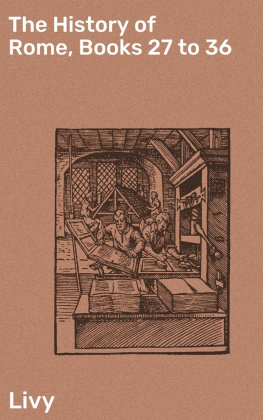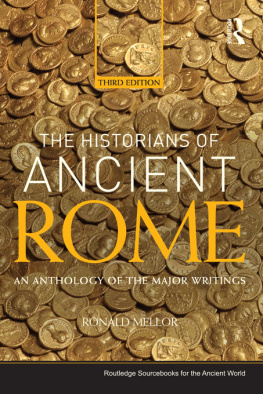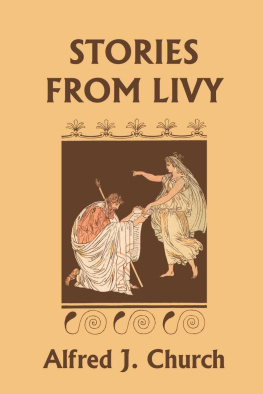
THE EARLY HISTORY OF ROME
TITUS LIVIUS was born in 59 BC at Patavium (Padua) but later moved to Rome. He lived in an eventful age but little is known about his life, which seems to have been occupied exclusively in literary work. When he was aged about thirty he began to write his History of Rome, consisting of 142 books of which thirty-five survive. He continued working on it for over forty years until his death in AD 17.
AUBREY DE SLINCOURT, scholar and translator, translated Livys The Early History of Rome (Books I-V) and The War with Hannibal (Books XXI-XXX), The Histories of Herodotus and The Campaigns of Alexander by Arrian, all for Penguin Classics. He was born in 1896 and educated at the Dragon School, Oxford, at Rugby, and at University College, Oxford. A schoolmaster of genius for twenty-six years, he retired in 1947 to the Isle of Wight where he lived until his death in 1962.
ROBERT OGILVIE was born in 1932 and educated at Rugby and at Balliol College, Oxford. He was a Fellow of Clare College, Cambridge, from 1955 to 1957 and of Balliol from 1957 to 1970. He was headmaster of Tonbridge School from 1970 to 1975 and subsequently Professor of Humanity at the University of St Andrews until his death in November 1981.
His publications include commentaries on the Roman authors Livy and Tacitus, and books on Roman religion, the history of early Rome and Lactantius. He was a Fellow of the British Academy and the Royal Society of Edinburgh.
STEPHEN OAKLEY was born in 1958 and was educated at Bradfield College and Queens College, Cambridge. He is Reader in Classics at the University of Reading. His principal publication is A Commentary on Livy: Books VIX (Oxford University Press, volume one, 1997; volume two, 1998; volume three, forthcoming).
LIVY
The Early History
of Rome
Books IV of
The History of Rome from Its Foundations
Translated by
AUBREY DE SLINCOURT
With an Introduction by
R. M. OGILVIE
and a Preface and Additional Material by
S. P. OAKLEY
PENGUIN BOOKS
PENGUIN BOOKS
Published by the Penguin Group
Penguin Books Ltd, 80 Strand, London WC2R 0RL, England
Penguin Putnam Inc., 375 Hudson Street, New York, New York 10014, USA
Penguin Books Australia Ltd, 250 Camberwell Road, Camberwell, Victoria 3124, Australia
Penguin Books Canada Ltd, 10 Alcorn Avenue, Toronto, Ontario, Canada M4V 3 B2
Penguin Books India (P) Ltd, 11 Community Centre, Panchsheel Park, New Delhi 110 017, India
Penguin Books (NZ) Ltd, Cnr Rosedale and Airborne Roads, Albany, Auckland, New Zealand
Penguin Books (South Africa) (Pty) Ltd, 24 Sturdee Avenue, Rosebank 2196, South Africa
Penguin Books Ltd, Registered Offices: 80 Strand, London WC2R 0RL, England
www.penguin.com
This translation first published 1960
Reprinted with a new introduction 1971
Reprinted with additional material 2002
I
Copyright Aubrey de Slincourt, 1960
Introduction copyright R. M. Ogilvie, 1971
Editors Preface and Additional Material S. P. Oakley, 2002
All rights reserved
The moral right of the editor has been asserted
Except in the United States of America, this book is sold subject to the condition that it shall not, by way of trade or otherwise, be lent, re-sold, hired out, or otherwise circulated without the publishers prior consent in any form of binding or cover other than that in which it is published and without a similar condition including this condition being imposed on the subsequent purchaser
ISBN: 9781101487501
CONTENTS
THE EARLY HISTORY
OF ROME
MAPS
For books 2 to 5, dates have been added to the text at the top of each page; these follow the conventional Varronian chronology adopted by modern scholars. For book I, in which Livys material is not dated, the reign of the appropriate king is recorded at the head of the page.
References in the Introduction, Appendix and at page-heads are to the Latin text of Livy.
PREFATORY NOTE
Aubrey de Slincourt published his translation of these books of Livy without a full scholarly introduction. This lack was made good in 1971, when Penguin Books commissioned a new essay from Robert Ogilvie to replace de Slincourts own introduction. Ogilvies finest scholarly achievement was his A Commentary on Livy, Books 15, published by the Clarendon Press in 1965. This commentary immediately established his reputation as one of the great Livian scholars and still remains a work of reference fundamental for anyone interested in the first five books of Livy and in the earliest history of Rome. Ogilvie was therefore better qualified than anyone else to introduce a translation of these books and he provided an essay that is informed, succinct and lucid. Since most of what he wrote remains true today, his essay has been reprinted intact. Another reason for preserving it is that it is the only general introduction to these books of Livy that he wrote.
However, Ogilvie provided no general bibliography, and the progress of classical scholarship since 1971 makes it likely that he would now say some things rather differently. Accordingly, the main purpose of the appendix at the end of this volume is to supplement Ogilvies introduction by (i) evaluating the more important bibliography on the subjects which Ogilvie discussed, (ii) suggesting modifications to some of Ogilvies opinions, and (iii) writing at greater length about some subjects upon which Ogilvie touched only briefly.
S. P. Oakley
INTRODUCTION
LIVY
Livy (Titus Livius) was born at Padua in northern Italy in 59 BC, or possibly 64 BC. It is notable that he is not referred to by any contemporary writer. He died at Padua, not Rome, in AD 17.
The first five books, which deal with the period from the foundation of Rome to the Gallic occupation in 386 BC, were conceived and published as a whole. They have a unity of design and construction, with the Commission of Ten at the centre and Camillus great speech, echoing the foundation of the city, at the end. The Preface is a preface to these five books and not to the complete work nor to the first book alone. Internal references, such as the closing of the Temple of Janus (I.19.3), suggest that Livy began his task in 29 BC and finished the five books by 27 BC, but the version which we have is almost certainly a revised edition published in or after 24 BC, because the excursus on Cossus (IV.20.511) with the reference to sacrilege is an awkward addition which contradicts the narrative, and can only have been composed after Augustus had adopted the title of Divi filius son of god. 29 BC is a plausible starting date. The Battle of Actium in 31 BC had brought an end to the Civil Wars. However uncertain the future might be, some security and stability had been restored to the world, which might encourage a historian to take stock of the situation. It is no accident that the Greek historian Dionysius of Halicarnassus, who was to cover in his History the same ground as Livy, arrived in Rome in 30 BC
Livy, therefore, differed from the great majority of his predecessors in that he was not a public man: he did not turn to history as a recreation. For him it was life. We would not expect to find in him the crude political interpretations of history, discussed in the following section, which characterized the approach of earlier writers. Yet it would be a mistake to think of Livys history as unconcerned with the problems of his generation. The difference between Livy and the others is that his philosophical detachment enabled him to see history in terms of human characters and representative individuals rather than of partisan politics. Livy accepted a tradition going back to Aristotle (especially in the










